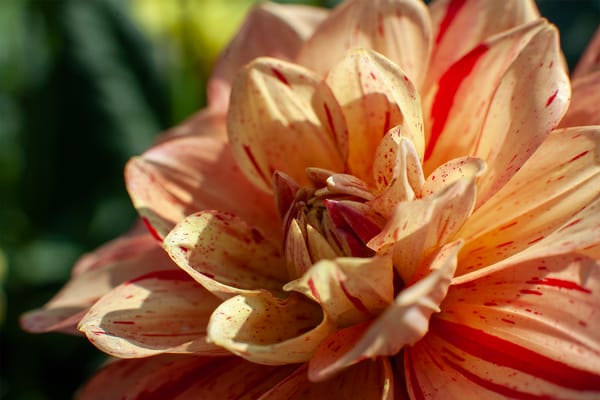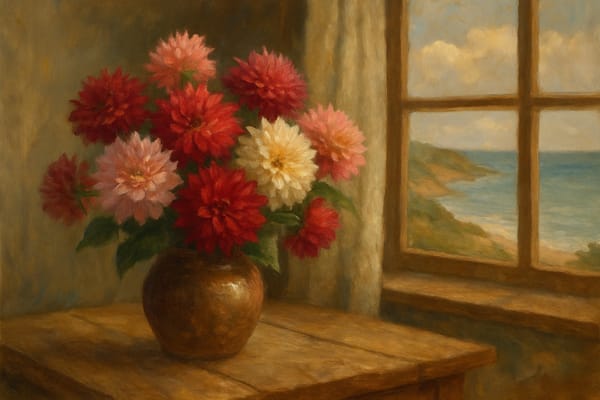In the Cornish garden, few flowers command attention like the dahlia. Come late summer, its blooms rise in a blaze of colour — some soft and pastel, others rich, dark, and velvet. But beneath this outward splendour lies a deeper story, woven through centuries of symbolism, myth, and whispered folklore. A flower of both light and shadow, the dahlia has always carried a dual nature — captivating the hearts of gardeners while harbouring darker tales of betrayal, resilience, and transformation.
The Secret Language of the Dahlia — From Admiration to Betrayal
In the Victorian era, flowers spoke when words dared not. Floriography — the language of flowers — turned bouquets into intricate messages. Dahlias, with their layered petals and striking forms, became a symbol of inner strength, grace under pressure, and lasting commitment. They featured in wedding posies and friendship tokens, often gifted as a sign of steadfast love or quiet courage.
Yet not all Victorian interpretations were so benevolent. The darker side of dahlia symbolism crept in, particularly tied to certain colours. Deep burgundy or near-black dahlias became covert emblems of betrayal, dishonesty, or looming change. Their intensity hinted at secrets kept and trust broken — a quiet warning within a genteel arrangement.
These shadows grew in the cultural imagination with the rise of the infamous “Black Dahlia” — a term forever linked to the unsolved 1947 murder of Elizabeth Short. Though named after her fondness for dark attire and the popular 1940s film The Blue Dahlia, the association gave the flower a new, chilling layer of modern folklore, entwining beauty with macabre legend.
Aztec Legends — The War Flower and the God of Battle
Long before Victorian intrigue, the dahlia was steeped in Aztec mythology. Known as the “War Flower,” it was entwined with the story of the Earth Goddess, Serpent Woman. According to myth, she was commanded by the gods to impale a blood-red dahlia upon an agave spine and hold it to her heart through the night. By dawn, she birthed Huitzilopochtli — a god of war, emerging fully armed and thirsting for battle. The dahlia, with its fierce red petals, came to symbolise strength, sacrifice, and power.
Beyond myth, the Aztecs embraced the dahlia for its practical uses. The hollow stems of the tree dahlia (Dahlia imperialis) carried water like natural pipes, while its roots were used medicinally. A flower of utility and reverence, both beautiful and essential.
A Bloom with Two Faces — From Mexican Hillsides to Cornish Borders
When dahlias crossed the Atlantic to Europe, they quickly captured the fascination of botanists and emperors alike — Empress Josephine of France among their most famous admirers. In Victorian Britain, they fuelled a kind of “Dahlia Mania,” their bold, exotic forms standing out among cottage borders and grand estate gardens.
But their journey from sacred Aztec symbol to European garden darling didn’t strip away their layered meanings. Even now, in the quiet corners of a Cornish border, dahlias bloom with whispers of both power and peril — a flower that honours resilience yet reminds us of nature’s darker stories.
Colour Meanings — The Dahlia’s Many Faces
| Dahlia Colour | Symbolism |
|---|
| Red | Passion, strength, power |
| White | Purity, new beginnings |
| Purple | Royalty, spiritual awakening |
| Pink | Admiration, grace |
| Yellow/Orange | Warmth, joy, positivity |
| Black/Burgundy | Betrayal, dishonesty, mystery, grief |
A Modern Symbol of Mexican Identity and Resilience
Today, the dahlia stands as Mexico’s national flower — a living emblem of the country’s natural heritage, resilience, and cultural pride. Officially recognised in 1963, it represents not only the vibrancy of Mexican flora but also the spirit of a people who, like the flower, thrive in both rugged and beautiful conditions.
The dahlia’s presence in Day of the Dead altars echoes its ancient role as a symbol of the life-death cycle, guiding loved ones home with its vivid colours. Its forms are celebrated in Mexican art, festivals, and folklore — a constant reminder of strength, devotion, and beauty born of hardship.
Conclusion — A Bloom of Light and Shadow
Whether nestled in a Cornish cutting patch or standing proud in a Mexican hillside, the dahlia is never just a flower. It’s a tapestry of myth, resilience, beauty, and shadow — a bloom that speaks of loyalty and betrayal, of grace and dark intrigue. In every petal, its layered history unfurls, offering not just colour for the garden, but a rich, resonant story for those willing to look a little closer.











